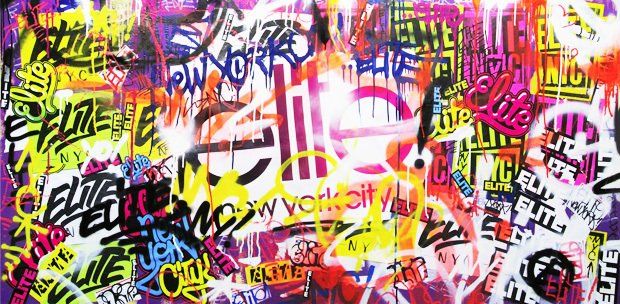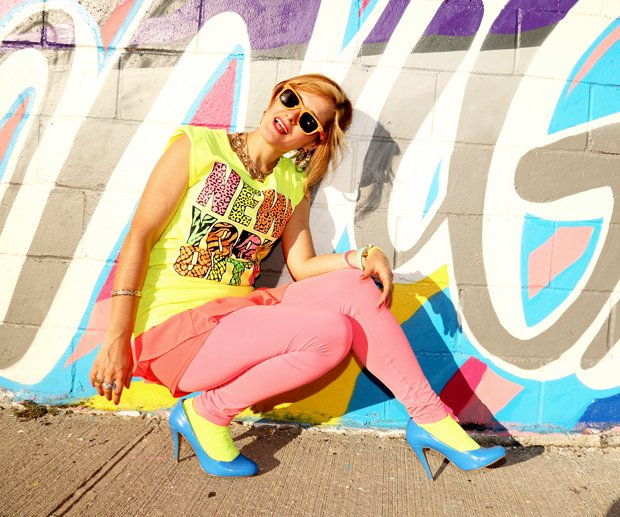Artist Spotlight: Andrea von Bujdoss
Dave Pouncey • February 26, 2020
Everyone’s work is deeply idiosyncratic: in our regular Spotlight segment we explore artists’ experiences and inspiration to understand what defines and inspires their unique styles.
Bold and colorful and certainly inspired by her environment Andrea von Bujdoss tells us what inspires her.

Can you give us a brief background on yourself?
As a New Yorker, I grew up in the vibrant neighborhoods of downtown Manhattan in the 1980s and 1990s. These neighborhoods were full of exciting subcultures such as graffiti, street art, skateboarding, raves, punk rock, and clubs. So I've been deeply inspired by the urban landscape from an early age, but I was particularly intrigued by graffiti. As a young teen, and part of a newer generation of early 1990's graffiti writers, I became friends with some of the most prolific old school subway graffiti writers. I began to teach myself the complicated art form of graffiti by consistently practicing my letters and graffiti style. I’ve always loved lettering, design, and drawing from a young age. I would sketch and draw for hours everyday as a teen. Then I would go out with friends and paint in the street. I eventually developed my own unique style and went on to earn my BFA at Parsons School of Design. I began a successful career working for worldwide brands and magazines who appreciate my passionate knowledge for typography, branding, and visual communication. Since the early 2000's, I have consistently painted murals and graffiti in the streets of New York City and other major US cities, as well as Paris, Amsterdam, and Tahiti. These days as a full time artist, I work on new paintings for exhibitions as well as large scale murals, branding, illustration, commissions, lettering, and apparel. I've spent nearly 20 years perfecting my graffiti and typography skill sets and I'm always developing new styles. It is really fun work and an exciting journey as a creative.
What kind of influence does your location have on your career?
My hometown New York City is the most amazing city in the world, in my opinion! Not only is it bustling with great galleries, museums, and advertising agencies. It is also a multicultural city full of people from diverse backgrounds, which is such an important aspect of vibrant communities. My work is definitely influenced by the diversity around me and I find it exciting to visually translate my experience of urban life. Some of my work incorporates clashing combinations of different patterns and phrases, which basically conveys diversity through interesting visual juxtapositions. Being in New York City is also great because it's home to some of the best advertising and media companies, so there's a huge amount of creativity and innovation buzzing here.
What is your greatest source of inspiration?
Typography and color are my biggest sources of inspiration at this point in my career. I love researching vintage lettering styles and following the evolution of typographic styles in advertising and media. Letters can be illustrated to convey powerful messages and affirmations. My work includes song lyrics and inspirational phrases that I paint as large scale murals or detailed digital illustrations, to create a big impact for those particular phrases. It’s an ongoing obsession with letters! I also explore different color palettes in my work by researching trends in art history and in nature. The natural world is a huge inspiration for my color palettes and color combinations, especially tropical nature.
Could you pick one piece of art that has made a lasting influence on you, and if so why?
The "LOVE" typography sculptures and prints created by pop artist Robert Indiana have had a big influence on me. They're so bold and iconic, and were unlike anything else at the time when he debuted them. I used to work at a design studio across the street from one of these sculptures in midtown Manhattan, and it was just amazing to see his sculpture every day. I think Robert Indiana opened the door for such bold letter-based works. The clever typography and positive message are very direct and appealing. The fact that these sculptures were placed on such busy streets in Manhattan is incredible, they have become iconic public works of art.
Drawing and sketching is a fundamental method that I always use to generate ideas and explore ways to express concepts or phrases visually. There are so many digital programs and new devices to illustrate with, but I think traditional drawing on paper is a beautiful practice that shouldn't be forgotten. It’s fun and liberating to let your mind wander and to just draw. For my paintings, I mix a lot of custom colors and use tiny brushes for my detail work. Most of my paintings incorporate hard edged shapes instead of free form brushwork. My work can be abstract and wild, but it’s always precise and graphic in terms of composition and production. When I’m digitally refining my illustrations on computers, I use a few digital tablets with pens, including portable ones when I'm on the go. Using tablets and pens are much faster for digital illustration. Working this way basically mimics my pencil-and-paper traditional drawing style, which is pretty much impossible using a mouse. The settings and short cuts on digital tablets with pens make my process very efficient when I’m re-coloring or adding effects to my vectorized artwork.
How can people who are interested in discovering more of your work find it?
You can find me on Instagram, my handle is @queenandreaone
and also at www.superfreshdesign.com.
Cheers, Scriba!
Scriba is a revolutionary digital stylus that is ergonomically designed to comfortably fit your hand and uses unique Squeeze-Motion technology. Order here.
Articles

The United Nations has described the disruption to education caused by the pandemic as ‘unparalleled’. At the virus’ worldwide peak in April, it is estimated that over 90% of all enrolled learners, from kindergarten to bachelors and beyond, had their education affected by school closures and the pandemic (UNESCO). For many university students and older children, they have had to adapt quickly to online learning. They can keep in touch with their peers and teachers online and continue their studies, albeit in a highly modified way. As challenging as this may be, this experience will help equip them for a future that is increasingly online. For parents of younger children, they are assuming a new role: their child’s home school teacher. This is in addition to their usual childcare and household duties, their work responsibilities and often emotional and financial worries caused by the pandemic. Stressful? Yes. The good, and somewhat surprising, news? The experts advise that you don’t teach your children - at least not in the way you might expect.

If the recent outbreak of Covid-19 has taught us anything, it's that many adults do not wash their hands effectively. It has never been more important that we support our children to develop good personal hygiene to keep themselves and our families safe. This seemingly easy task can be very difficult for children with fine motor skill difficulties. In this article, we explore some ideas to support your child with hand washing.

Lockdown has brought the digital future into the now. Online shopping, entertainment, education and more have moved from the periphery to the mainstream to, in many cases, the only option. With the necessity of social distancing looking to continue for many months, it appears that this rapid digital revolution is here to stay. This means that life as we know it, in most of its sectors, has changed forever. In order to survive, businesses are having to adapt rapidly, embrace technology and look to the future. Architecture is no exception. There has been a widespread adoption of technology and VR over the past few months in response to the lockdown across all of society. Elderly grandparents who were once resistant to adopt new technologies talk of “Zooming” and have started video chatting with their family members to combat loneliness. Art galleries that were once considered stuffy or pretentious are now pioneers in VR technology, with Google Art & Culture offering tours of London’s National Gallery or the Musee D’Orsay in Paris. These virtual tours deliver art in a dynamic new way that can be far more engaging than regular photos. Critics have applauded the panoramic and immersive views of gallery building and exhibitions which work well for rendering of 2 dimensional art, however impressions of sculpture is somewhat lacklustre. With VR technology, users can enjoy a truly immersive experience in the comforts, and safety, of their own home. The COVID-19 pandemic has served as an accelerant for the arts and entertainment industries to embrace VR.





